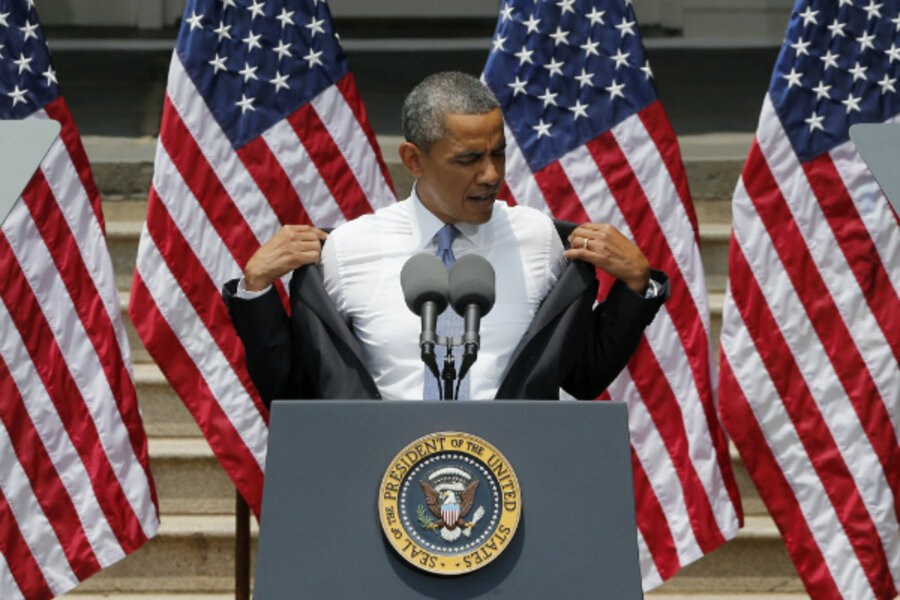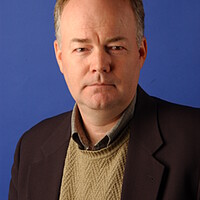Climate change: Obama announces new curbs on existing power plants
Loading...
Seeking to propel the US faster into the fray on curbing climate change, President Obama laid out an aggressive plan Tuesday to sharply curb smokestack emissions of existing coal-fired power plants and to double wind, solar, and other renewable energy production from today’s levels.
Under a hot summer sun, wiping his brow repeatedly as if to underscore the presence of global climate change, Mr. Obama told an audience of students at Georgetown University that future generations of Americans – including their children – would have to live with the consequences of current US climate policy.
“We don't have time for a meeting of the flat earth society,” Obama said. “Sticking your head in the sand might make you feel safer, but it's not going to protect you from the coming storm. And ultimately, we will be judged as a people and as a society and as a country on where we go from here.”
Though welcoming any support from lawmakers, he said he would forge ahead even without help from Congress, which has not been able to pass a climate change bill since Obama took office.
In going it alone, the president framed his program in terms of what he could accomplish solely with regulatory power of the executive branch in three areas: cutting carbon pollution using the Clean Air Act; preparing the US for the worst impacts of climate change through investment in infrastructure and technology; and leading diplomatic efforts to address the issue internationally.
Measures, he said, would include developing new efficiency standards for buildings and appliances, expanding energy sources like solar and wind on public lands, and bolstering climate-change affected communities. It would also mean investments in a hardened power grid, highways, sea walls, and other infrastructure to prepare for more damaging storms and other impacts of global warming.
The fate of the controversial Keystone XL pipeline, he suggested, would be determined by whether or not it would contribute to global warming through a net increase in greenhouse gases – or not.
By far, the most significant and controversial part of the plan is his new mandate for the Environmental Protection Agency to develop regulations limiting greenhouse gas emissions from both new and existing coal-fired power plants. It's that part of the plan that holds the potential to reap huge gains – slashing carbon emissions as much as 500 million tons a year, according to a recent study by the Natural Resources Defense Council.
The electric utility industry is the single largest source of greenhouse gas emissions in the United States, accounting for one-third of total US greenhouse gas emissions and about 40 percent of all carbon pollution from fossil fuel burning.
Newly proposed power plants were already in the EPA's cross-hairs for greenhouse gas regulations under the Clean Air Act. But the president’s move to expand such controls to existing plants can, all by itself, get Obama a long way toward his goal of a 17 percent reduction in US greenhouse gas emissions – from 2005 levels – by 2020.
There are, so far, precious few details on how the EPA will handle this mandate. But clues as to how it might happen can perhaps be found in recent reports by environmental groups – and in the president’s speech.
Obama spoke about “directing the EPA to develop these standards in an open and transparent way, to provide flexibility to different states with different needs and build on the leadership that many states and cities and companies have already shown.”
That flexibility mandate could easily end up mirroring a state-by-state averaging approach to carbon emissions from power plants, which was detailed in an influential NRDC plan that appeared in December, several energy experts said.
Under that plan, EPA would, first, set state-specific emissions rates, “reflecting the diversity of the nation’s electricity sector.” Second, it would give power plant owners and states broad flexibility to meet standards in the most cost-effective way. The EPA would then set emissions standards – the rate of carbon emissions – for power plants by first tallying the share of electricity generated by coal and gas-fired plants in each state during a set of baseline years – in the NRDC example, 2008-10. Then, the agency would set a target emission rate for each state for 2020, based on the state’s baseline share of coal and gas generation.
Finally, the emissions standard for each state would be a cumulative, overall emission rate average of all fossil fuel plants in the state. Under that umbrella, an individual plant could emit at a higher or lower rate, the NRDC plan suggests.
“Under a plan the NRDC has proposed, the Environmental Protection Agency could develop safeguards under which each state would have its own carbon reduction target, tailored to its specific energy mix,” said President Frances Beinecke, in a statement this week. “Utilities would have the flexibility to find the most cost-effective way to hit the target.”
Computer modeling of the NRDC plan, which used the same model used by the EPA, suggests that if the EPA does follow this approach, the US could see a 26 percent cut in power plant emissions – and an overall reduction in the US carbon footprint of 10 percent by 2020 – the largest share of achieving the 17 percent reduction the president has called for.
But it could also mean closing many conventional power plants that can’t meet even flexible emissions standards – and that worries the utility industry.
The electric generation fleet “is in the midst of a major transformation to a significantly cleaner fleet as a result of several factors,” acknowledged Tom Kuhn, president of the Edison Electric Institute, the trade group representing 70 percent of the US electric power industry.
Concerning the president’s plan, the industry wants ”achievable compliance limits and deadlines,” he said, in a statement. “We look forward to working with the administration as it further develops its climate plan and with other key stakeholders, including Congress and the states, which will play a critical role in helping to forge workable regulations.”
Anticipating opposition in Congress and among industry groups, Obama took on his critics in advance, noting that past regulatory measures that cleaned up smog and acid raid were, at the time, predicted to have drastic impacts on the economy. That didn't happen, Obama said.
“Now, what you will hear from the special interests and their allies in Congress is that this will kill jobs and crush the economy and basically end free enterprise as we know it,” Obama said. “The reason I know you'll hear those things is because that's what they've said every time America sets clear rules and better standards for our air and our water and our children's health. And every time, they've been wrong.”
The alternative, he noted, is that those in positions of responsibility “will need to be less concerned with the judgment of special interests and well-connected donors and more concerned with the judgment of posterity – because you and your children and your children's children will have to live with the consequences of our decisions.”








